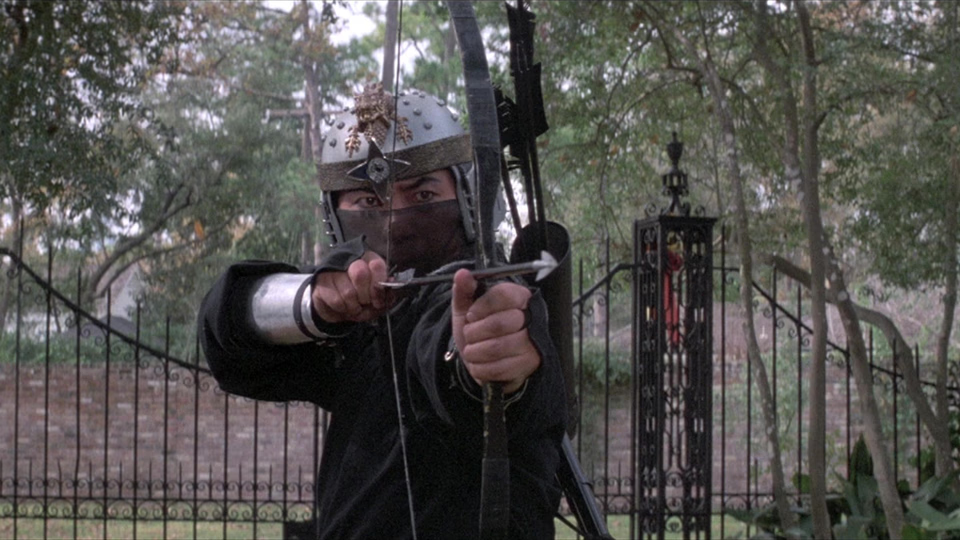Pray for Death

Pray for Death breaks the first rule of revenge exploitation pictures: it takes forever to get to the revenge.
The plot concerns a Japanese businessman, played by Shô Kosugi, who immigrates to Los Angeles with his wife and two young sons to start a business. Unfortunately, the location he’s purchased for his new restaurant is also a dead drop site for some corrupt cops and gangsters. When a stash of jewels goes missing, the criminals lean on Kosugi and threaten his family, leading Kosugi to suit up and take down the criminals ninja style.
Not a bad plot as such films go, but director Gordon Hessler1 squanders its potential through a series of baffling choices. We wait almost 40 minutes before reaching the inciting incident, sitting through a needless prologue in Japan, a go-nowhere subplot involving Kosugi’s brother, and multiple scenes of his older son beating up kid bullies. Aside from a brief opening sequence that’s revealed to be a television show, there’s no ninja action until the film’s third act.
Hessler’s direction proves equally problematic in the action sequences, which lack any sense of tension or atmosphere. In one scene, Kosugi sneaks aboard a cruise ship to intimidate a gangster heavy. Instead of creeping through the shadows, he winds through bright, flatly lit corridors, dispatching a small army of goons, none of whom think to simply shoot him. Only at the sequence’s end does Kosugi finally kill the lights, creep up behind the heavy, and deliver the film’s titular threat to back off lest the heavy “pray for death.”
The film’s visual continuity fares no better. When we first meet the gangsters, their beanie caps and polyester suits suggest a period piece set in the 70s, but after that initial scene, they wear contemporary clothes—nothing says mid-80s like a Members Only jacket—and talk on cell phones. Even basic action scenes suffer from poor execution: during a car chase, a vehicle taps the rear bumper of a parked car, inexplicably causing both cars, and a third, to burst into flames.
The script’s tonal inconsistencies prove equally jarring. The scenes featuring Kosugi’s pre-teen son would fit in a kid’s picture—think a pre-teen Karate Kid—but clash with the film’s adult content, which includes multiple murders, graphic torture, and rape. This disconnect reaches its apex in the finale, where a lighthearted ending plays out as the characters stand over the grave of a murdered family member.
It’s not all bad. The stunt work impresses, particularly a shot of Kosugi somersaulting over a truck attempting to run him down. The supporting cast also shines, with James Booth relishing his role as the gangster heavy nicknamed Limehouse. He transitions from gritty thug to over-the-top sadistic martial arts master as the film progresses, and Booth seems game for the ride. Donna Kei Benz brings surprising charisma to her role as Kosugi’s wife, as does Norman Burton as an exasperated police lieutenant.
Genre aficionados might find entertainment in the film’s peculiar choices, like setting its finale in a mannequin factory—seemingly a nod to Stanley Kubrick’s Killer’s Kiss—or Kosugi’s ornate ninja helmet, designed to shield his face from bullets but worn mostly open. However, most viewers would be better served by Kosugi’s prior film, Revenge of the Ninja, which features a similar plot but superior execution.
Notes
-
Gordon Hessler had quite an interesting genre career, having begun as a producer on the The Alfred Hitchcock Hour then directing Vincent Price, Christopher Lee, and Peter Cushing in films like The Oblong Box and Scream and Scream Again, then working with Ray Harryhausen on The Golden Voyage of Sinbad, before spending almost a decade as a journeyman television director. ↩︎